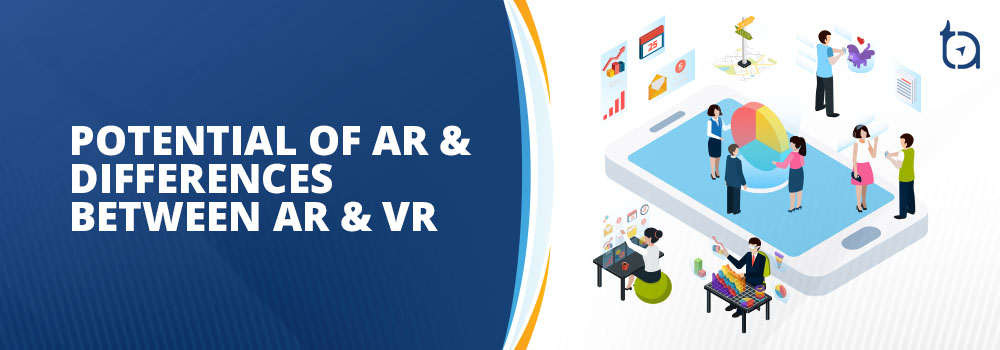How can AR Expand your Business? How is it Different from VR?

Author : Amarnath S 15th May 2020

Augmented RealityAugmented RealityAugmented Reality (AR) transforms the objects available in the real-world augmented and provides an interactive experience of a real-world environment. Mostly, these computer-generated augmentations are perceptual information, sometimes across sensory modalities, including auditory, olfactory, somatosensory, visual and haptic. is an emerging technology and has a huge potential that continues its growth in the software industry. It adds very good commercial value with a high future potential in many industries, especially with mobile apps, plays a vital role in the retail industry. Retailers are yet to tap the full potential of AR. It enables animated advertisements for their consumers, which in turn increases the revenue growth for the retail industry.
AR’s Impact on Retail, Entertainment, and More

According to Retail Perceptions, “61% of shoppers prefer to shop at stores that offer Augmented Reality for assistance.” Adding Augmented Reality to a store’s app or website creates an engaging buying experience and allows the consumer to experience what the product would be like in reality. This, in turn, creates a more confident purchase.
Augmented reality (AR) provides an advanced interactive experience of a real-world environment for users, where they can place objects in the real world which are superimposed with the additional details and interactive objects – computer-generated images added to the real-world environment providing a composite view. It does not bring the users to a virtual environment instead, it’s a combination of the real and virtual world objects that brings the wow factor for users.

The augmented reality system effectively generates the visual appearance for users to view the combination of a real scene and a virtual scene generated by mobile/web applications. The UXUXUser Experience Design (UXD, UED, or XD) is the process of manipulating user behavior through usability, accessibility, and desirability provided in the interaction with a product. User experience design encompasses traditional human–computer interaction (HCI) design and extends it by addressing all aspects of a product or service as perceived by users. Experience design (XD) is the practice of designing products, processes, services, events, omnichannel journeys, and environments with a focus placed on the quality of the user experience and culturally relevant solutions. design for the web and mobile applications has been massively upgraded with the use of augmented reality technology. It increases user interaction with applications by proving a rich and sophisticated user experience.

Today, augmented reality is much needed in sectors such as entertainment and military training. Virtual simulation is also mixed with the real environment, engineering design, robotics, and manufacturing industries. The medical industry has benefited from technology like the use of operating magnetic resonance imaging equipment to perform complex surgeries. Augmented reality is used to improve natural environments or situations and offer perceptually enriched experiences.

The combination of artificial intelligence & augmented reality takes the user experience of the social media application to the next level.
Difference Between Virtual Reality and Augmented Reality
In Virtual Reality (VR) the user experience of the reality is fully based on the virtual information and no real environment is in place. It’s mostly used in the gaming and educational sectors. It basically provides a simulated experience for the users which provides the virtual environment for the users.

VR headsets and motion controllers are used to experience Virtual realityVirtual realityVirtual reality is a simulated experience that can be similar to or completely different from the real world. Applications of virtual reality can include entertainment and educational purposes. Other, distinct types of VR style technology include augmented reality and mixed reality. in video games with Realistic images, sounds, and sensation simulators. Augmented Reality (AR) differs from Virtual Reality (VR) where the surrounding environment view by the users is the real environment and is just adding layers of virtual objects to the real environment. This provides enhanced user experience for the users since they access the virtual objects in the live environment.

Diffractive waveguides and reflective waveguides are the two technologies widely used in Augmented Reality. Computing devices like smartphones and tablets which have hardware components such as processor, display, sensors, cameras, and microelectromechanical systems like accelerometer, GPS, solid-state compass, etc. will support the AR-based mobile apps.
Geo-based augmented reality works in the mobile application and provides interactive information related to the user current location – it’s called Location-based Augmented Reality that allows the mobile app user to view the interactive and digital content respective to the geo-based markers. Geo AR technology adds the interactive digital content to geographical points of interest it’s been effectively utilized in the car navigation-based mobile application.
At TechAffinity, we have expert developers who cater to the client’s needs on developing robust augmented reality supported apps. Feel free to email your queries at media@techaffinity.com or schedule a meeting with our AR experts.
